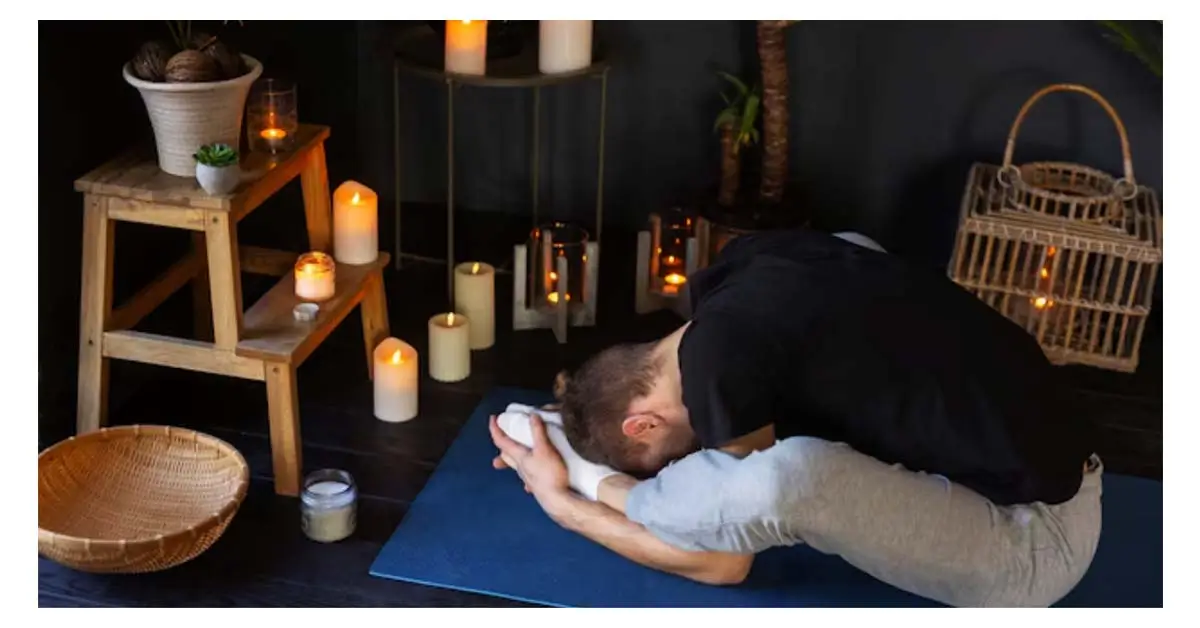Learn your path to inner harmony with this comprehensive step-by-step guide. Learn how to find your spiritual home, nurture personal growth, and embrace peace daily.
Thank you for reading this post, don't forget to subscribe!Where to Find Your Spiritual Home
Finding inner peace can seem elusive during life’s chaos. However, discovering your spiritual home can be the key to unlocking a life filled with harmony and purpose.
A spiritual home is not a physical place; it’s a state of being where your soul feels aligned, your mind feels calm, and your heart feels whole. It’s your sanctuary—a space to reconnect with yourself and your values.
This guide will help you uncover your spiritual home. It offers practical steps, insights, and inspiration to cultivate inner harmony. Whether you’re new to spirituality or seeking to deepen your connection, this roadmap will guide you every step of the way.
Understanding the Concept of a Spiritual Home
A spiritual home is a refuge where your inner self feels at peace. It’s deeply individual, shaped by your beliefs, values, and life experiences.
While some might associate it with religion, others find it through mindfulness, nature, or creative expression. The key is understanding what brings you serenity and a sense of purpose.
What is a Spiritual Home?
Your spiritual home is a reflection of your inner world. It is the core of your being where you feel genuinely authentic, connected, and aligned. Unlike physical locations, it doesn’t depend on where you are but on how you feel within.
It’s not about following societal norms or external expectations but embracing what genuinely resonates with your soul. This space allows you to:
- Reflect on Your Purpose: Your spiritual home provides the clarity needed to understand your life’s direction. In this space, you can ponder your values, goals, and the deeper meaning behind your actions.
- Recharge Your Mental and Emotional Energy: Just as your body needs rest, your mind and spirit require a sanctuary to rejuvenate. Your spiritual home offers this refuge, allowing you to process emotions and regain balance.
- Feel a Deep Connection to Something Greater Than Yourself: Whether it’s a connection to nature, a higher power, or the universe’s energy, your spiritual home fosters this bond, giving you a sense of belonging and purpose.
This personal sanctuary is not static. It evolves with your growth, adapting to new insights, challenges, and triumphs. No matter how far you stray, you can always return to it to rediscover your peace and authenticity.
Misconceptions About Spirituality
Spirituality is often confused with religion, but it’s a broader concept. It doesn’t require adherence to a specific faith or doctrine. Instead, spirituality is about exploring one’s inner self, cultivating self-awareness, and achieving emotional well-being.

It embraces practices and beliefs that help one connect with one’s authentic essence and the world.
Key misconceptions and clarifications:
- Spirituality Requires Religion: While religion can be a pathway to spirituality for some, others find it through meditation, art, nature, or simply spending quiet moments reflecting. Your spiritual home is uniquely yours and doesn’t have to fit traditional molds.
- You Need Formal Practices: Spirituality isn’t about rigid rules or rituals unless they resonate with you. It can be as simple as mindful breathing, journaling, or appreciating the beauty of a sunset.
- It’s Only for Certain People: Spirituality is universal. It’s not reserved for the devout or enlightened; it’s for anyone seeking peace, meaning, or a deeper understanding of themselves.
Spirituality is beautiful because it is flexible and inclusive. It empowers you to craft a personal journey that aligns with your beliefs, lifestyle, and aspirations. By letting go of preconceived notions, you can open yourself to the profound benefits of embracing your spiritual home.
Self-Reflection and Identifying Your Needs
Before you can find your spiritual home, you need to embark on a journey of self-reflection. This step is the cornerstone of your spiritual quest, allowing you to uncover what truly brings you joy, peace, and fulfillment.
Through introspection, you gain clarity about your inner desires and align your life with your authentic self.
Common Prompts for Self-Reflection
To delve into your inner world, take time to ask yourself meaningful questions. These reflections will help you identify your needs and desires. Consider:
- What activities make me feel alive?
Think about moments when you felt exhilarated, content, or deeply connected to life. These experiences often hold clues to your passions and purpose. - When do I feel the most at peace?
Reflect on situations or environments where you feel calm and grounded. Understanding these can guide you toward creating a sanctuary for your soul. - What values are most important to me?
Identify the principles that resonate with you, such as honesty, compassion, or creativity. Your values serve as a compass for your spiritual journey. - What do I want to let go of to find inner harmony?
Recognize habits, beliefs, or relationships that drain your energy. Letting go of these can create space for growth and renewal.
Journaling for Clarity
Journaling is a transformative tool for self-discovery. Set aside time each day to write freely about your thoughts, emotions, and aspirations. Don’t worry about grammar or structure; let your words flow naturally.
Over time, patterns and insights will emerge, revealing your spiritual needs and desires. Use questions like “What does inner peace mean to me?” or “What can I do to take care of my soul?” You can better organize your thoughts and keep a tangible record of your progress by keeping a journal.
Aligning With Your True Self
Finding your spiritual home requires embracing your authentic self. It means shedding societal expectations and external pressures. Take time to reconnect with your essence—the person you are beneath roles, labels, and masks.
Practice self-compassion and accept yourself as you are, flaws and all. This alignment with your true self forms the foundation of your spiritual journey, allowing you to live with integrity and purpose.
Exploring Different Spiritual Practices
Spiritual practices are invaluable tools for connecting with one’s inner self and fostering harmony. One can discover what resonates most with them by exploring various practices and creating a personalized routine that nurtures one’s spirit.
Meditation and Mindfulness
Meditation is one of the most effective ways to cultivate self-awareness. It involves focusing on a single point, such as your breath, a mantra, or a visualization.
Meditation quiets the mind, reduces stress, and connects you with the present moment. Begin with just a few minutes each day, gradually increasing the duration as you become more comfortable.
Mindfulness, on the other hand, is about giving your full attention to your daily activities. Whether eating, walking, or conversing, mindfulness invites you to be fully present and aware. These practices enhance your ability to live in the moment and foster inner peace and clarity.
Yoga and Movement
Yoga is a holistic practice that combines physical movement with mental discipline and spiritual awareness. Its various forms cater to different needs:
- Hatha Yoga: Gentle and beginner-friendly, focusing on basic postures and breathing techniques.
- Vinyasa Yoga: A dynamic flow of poses that synchronizes movement with breath.
- Yin Yoga: A slow-paced style that targets deep connective tissues and encourages relaxation.
Incorporating yoga or other forms of mindful movement, such as tai chi or dancing, helps release pent-up energy and strengthens the connection between your mind and body.
Gratitude and Affirmations
Gratitude is a powerful practice that shifts your focus from scarcity to abundance. Begin each day by listing three things you’re grateful for, no matter how small. This habit rewires your brain to notice and appreciate life’s blessings.
Affirmations are positive statements that reinforce empowering beliefs. For example, saying, “I am worthy of love and peace,” helps align your mindset with your goals. Speak or write affirmations daily to cultivate a sense of confidence and positivity.
Joining Similar Communities
Humans are inherently social; building connections with others who share your spiritual interests can significantly enhance your journey. Being part of a supportive community encourages and offers wisdom, shared experiences, and a sense of belonging that fosters growth and inspiration.
Finding Your Tribe
Discovering a community that aligns with your spiritual path requires exploration and openness. Research groups, organizations, or gatherings that reflect your values and interests. Consider the following avenues:
- Meditation Circles and Spiritual Retreats: Many communities host regular meditation sessions or retreats focused on mindfulness and spirituality. These gatherings provide an opportunity to connect with others while deepening your practice.
- Book Clubs and Study Groups: Join a group that discusses spiritual books or philosophical topics. Sharing perspectives and insights can broaden your understanding and spark meaningful conversations.
- Online Forums and Social Media Groups: In today’s digital age, platforms like Facebook, Reddit, or Meetup host communities dedicated to various spiritual practices. Participate actively in discussions to engage with like-minded individuals.
- Workshops and Local Events: Attend workshops on yoga, energy healing, and personal development. These events often attract individuals with similar goals, offering a chance to form lasting connections.
- Volunteer Work: Community service can connect you with kind, compassionate people and positively impact you.
Building Meaningful Relationships
Once you find a community, focus on creating authentic connections. Building meaningful relationships requires effort, vulnerability, and mutual respect. Here are key ways to deepen your bonds:
- Share Your Journey: Openly discuss your experiences, challenges, and aspirations. Authenticity fosters trust and invites others to share their stories in return.
- Practice Active Listening: Show genuine interest in others’ perspectives by listening attentively and without judgment. It cultivates mutual understanding and empathy.
- Offer Support and Encouragement: Celebrate others’ achievements and offer a helping hand during their struggles. A supportive attitude strengthens the sense of community.
- Participate Regularly: Be consistent in attending gatherings or engaging in online discussions. Regular involvement helps you form deeper connections over time.
- Respect Differences: Embrace the diversity of thought and practice within your community. Learning from others’ unique experiences can enrich your spiritual journey.
Creating a Ripple Effect
As you grow within your community, consider how you can contribute to its well-being. You can organize events, lead discussions, or mentor newcomers. Your active participation strengthens the community and reinforces your spiritual growth.
Cultivating a Sacred Space

A sacred space is a sanctuary to connect with your inner self and nurture your spiritual well-being. This physical area, imbued with intention, becomes a cornerstone of your spiritual journey.
Designing Your Space
Creating a sacred space involves thoughtful planning and personalization. Here’s how to design a space that inspires peace and connection:
- Choose a Location: Select a quiet, private area in your home where you feel comfortable and undisturbed. It could be a corner of a room, a balcony, or a garden.
- Incorporate Meaningful Items: Decorate your space with objects that resonate with your spiritual path, such as candles, crystals, statues, or artwork. Each item should hold significance and inspire tranquility.
- Add Comfort: Include cushions, a soft chair, or a cozy blanket to make the space inviting. Comfort enhances your ability to relax and focus.
- Use Natural Elements: Incorporate plants, stones, or water features to bring a grounding, earthly energy to your sanctuary.
- Set an Atmosphere: Use dim lighting, incense, or soothing music to create an ambiance that promotes relaxation and mindfulness.
Ritualizing Your Sacred Space
When used regularly and intentionally, your sacred space becomes genuinely transformative. Designate this area for meditation, journaling, prayer, or yoga. Establish rituals that resonate with you, such as lighting a candle before meditating or saying a gratitude prayer before journaling.
Maintaining Positive Energy
To keep your sacred space energetically vibrant:
- Cleanse the Space: Regularly clear negative energy by smudging with sage, using sound bowls, or simply decluttering the area.
- Refresh Its Energy: Rotate or update items to reflect your spiritual focus. It keeps the space dynamic and aligned with your growth.
- Protect Its Sanctity: Treat the area respectfully, using it only for spiritual or reflective activities.
Embracing Challenges and Growth
Challenges are inevitable, but they often hold the key to profound spiritual growth. By viewing difficulties as opportunities for learning, you can transform adversity into strength and wisdom.
Learning From Adversity
Every challenge you face provides an opportunity to reflect and grow. Here’s how to approach adversity with a growth mindset:
- Determine the lesson: “What can I gain from this experience?” Ask yourself. Challenges frequently provide insights into resilience or highlight areas for improvement.
- Developing self-compassion: Develop self-compassion by treating yourself with kindness when it is difficult.
- Acknowledge your feelings without judgment and remind yourself that struggle is a natural part of growth.
- Seek Guidance: Refer to mentors, spiritual texts, or your community for support and advice. Their perspectives can provide clarity and encouragement.
Letting Go of Negativity
Holding onto negative emotions can hinder your spiritual journey. Practice the following to release these burdens:
- Forgiveness: Let go of past grievances by forgiving yourself and others. It doesn’t condone harmful actions but frees you from carrying resentment.
- Mindful Release: Use techniques like deep breathing, journaling, or visualization to release anger, fear, or guilt.
- Gratitude Practice: Focus on the positive aspects of your life. Gratitude shifts your perspective and fosters a sense of abundance.
By embracing challenges and releasing negativity, you create space for new growth and a deeper connection with your spiritual self.
FAQs on Finding Spiritual Home
Q. How could I create and design my spiritual practices?
Creating and designing your spiritual practices starts with identifying what brings you peace and clarity. Reflect on your values and what aligns with your beliefs. Experiment with practices like meditation, journaling, or spending time in nature.
Choose activities that help you feel grounded and connected. Integrate rituals into your routine, like lighting a candle or saying affirmations. Personalize these practices to resonate with your unique journey. Remember, there’s no right or wrong way—let your intuition guide you. Start small, and let your practices evolve.
Q. How did you find your spiritual path?
Finding your spiritual path is a deeply personal experience. It often begins with self-reflection and a desire to explore your inner world—many start by reading books, attending workshops, or experimenting with practices like yoga or mindfulness. Listening to your intuition and noticing what resonates with your soul is key.
For some, challenges or life transitions act as catalysts for this discovery. Surround yourself with supportive communities or mentors who inspire you. Please keep an open mind and embrace the journey as it unfolds. You get closer to clarity with each step you take.
Q. How do you find your spiritual self?
Discovering your spiritual self involves tuning into your inner world and exploring what gives your life meaning. Start by spending time in stillness—meditate, journal, or sit quietly. Reflect on moments when you’ve felt deeply connected or inspired.
Explore practices that nurture your soul, such as art, music, or being in nature. Ask yourself, “Who am I beyond my duties and labels?” Will help you engage in self-inquiry.” Surround yourself with uplifting people and experiences. Embrace curiosity and be patient—it’s a journey, not a destination. Your spiritual self will reveal itself as you delve deeper.
Q. What are some ways to develop spiritual power at home?
Developing spiritual power at home starts with creating a sacred space where you can focus and feel at peace. Incorporate practices like meditation, prayer, or yoga into your daily routine. Use candles, crystals, or incense to set the mood. Practice mindfulness in your everyday tasks, like cooking or cleaning.
Dedicate time for gratitude and self-reflection. Read books or listen to music that inspires your spiritual growth. Make it a habit to disconnect from technology and connect with your inner self. Consistency is key to nurturing your spiritual power.
Q. How can I discover my spirituality?
Discovering your spirituality involves exploring what brings you peace, joy, and a sense of purpose. Begin by reflecting on your beliefs and values—experiment with various practices, like meditation, mindfulness, or exploring different philosophies.
Spending time in nature often provides clarity and a sense of connection. Seek out books, podcasts, or communities that align with your curiosity. Be open to new things and trust your instincts about what feels right. It’s okay to question and redefine your path as you grow. Remember, spirituality is a personal and evolving journey.
Conclusion on Finding Spiritual Home
Finding your spiritual home is a deeply personal and transformative journey. These steps will uncover a sanctuary within yourself where peace and purpose reside. Remember that the trip is just as significant as the final destination. Embrace each step with curiosity and compassion.
As Rumi so beautifully said, “When you let go of who you are, you become who you might be.” Let this guide inspire you to embark on your journey and create a life of inner harmony. Share your experiences, reflections, and breakthroughs in the comments below. We’d love to hear your story.
Read more articles on Health and Wellness Tips.
You might like to read:

